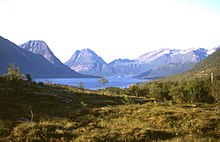Danish straits

TheDanish straitsare thestraitsconnecting theBaltic Seato theNorth Seathrough theKattegatandSkagerrak.Historically, the Danish straits were internal waterways ofDenmark;however, following territorial losses,ØresundandFehmarn Beltare now shared withSwedenandGermany,while theGreat Beltand theLittle Belthave remained Danishterritorial waters.TheCopenhagen Convention of 1857made all the Danish straits open to commercial shipping.[1]The straits have generally been regarded as aninternational waterway.
Toponymy and geography[edit]
Five straits are named 'belt' (Danish:bælt), the only ones in the world[clarification needed].Several other straits are named 'sound' (Danish, Swedish and German:sund). Where an island is situated between a "belt" and a "sound", typically the broader strait is called "belt" and the narrower one is the "sound":
- Als:
- separated from the continent byAlssund
- separated fromFynby the southern part of theLittle Belt,an area referred to in German (but not Danish) asAlsenbelt
- Fehmarn

seen fromHelsingborg
- Langeland:
- separated fromTåsingeIsland bySiø Sund(Tåsingeitself is separated fromFynbySvendborg Sund)
- separated fromLollandbyLangelandsbælt,the southern part ofGreat Belt
- Lolland:
- separated fromFalsterIsland byGuldborgsund(Falsteritself is separated fromZealandbyStorstrømmenStrait)
- separated fromLangelandbyLangelandsbælt
- separated fromFehmarnbyFemernbælt,which is the common continuation of Great Belt–Langelandsbælt and Little Belt
- Zealand(Danish: Sjælland)
- separated fromScandinavianpeninsula of the continent byØresund(Danish) /Öresund(Swedish)
- separated fromFynIsland by theGreat Belt
Etymology of "sound" / "sund"[edit]

TheGermanicword "sound" has the same root as the verbto sunderin the meaning of "to separate". TheOld Norseform of that verb issundr.In Norway hundreds of narrow straits separating islands and combiningfjordsor outer parts of fjords are named "Sund".
Another explanation derives "sound" from an ancient verb "sund" in the meaning of to swim. That way asoundis aswimmable strait.In theSwedish languageany strait is called "sund".
The Germanic word "sound" is not related to theRomance languagesoriginated word "sound", which has developed from theLatinsonus.[citation needed]
See also[edit]
References[edit]
- ^Law of the Sea Institute (1983).The Law of the Sea in the 1980s.University of Virginia: Law of the Sea Institute. p. 600.
